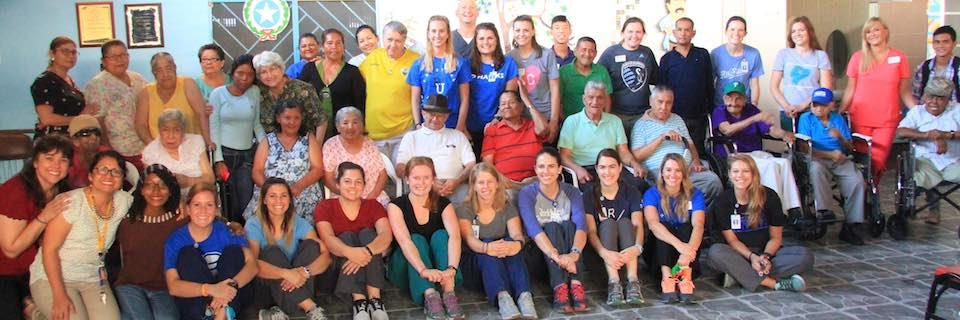OT, PT Students Celebrate 10th Service Trip to Ecuador’s Damien House

For those who suffer from what is now known at Hansen’s disease, stigma and isolation are common experiences.
More commonly known as leprosy, the disease is all but eradicated throughout most of the world because of a naturally occurring immunity. But there are areas where the disease is prevalent, and despite the fact that Hansen’s can be treated and is not nearly as contagious as once thought, often those with the disease are forced to live out their years in separation from family and friends.
It’s part of the reason why this year, for the 10th time, students from Rockhurst University’s occupational and physical therapy programs traveled to Guayaquil, Ecuador, this August to spend a week of their time and lend their skills to helping those living with Hansen’s disease.
The annual trip grew out of one of the University’s service immersion trips to Ecuador that included a tour of the Damien House, which serves as an inpatient home and outpatient clinic for those in the area with Hansen’s.
A tour of the Damien House was just one part of a packed itinerary that year, according to Liz Zayat, M.S., clinical assistant professor of occupational therapy. But during the tour, a group of occupational therapy students on the trip were stopped by Damien House founder Sister Annie Credidio. She asked them to come back and help.
So that’s what they’ve done, Zayat said — for all but one summer since, occupational therapy students and physical therapy counterparts began making an annual trip to the Damien House to serve as the volunteer staff for the center’s on-site clinic. Zayat said for the students, it’s a clinical experience unlike any they are likely to have in the United States — navigating differences in language and culture in an area where many people live in poverty or without basic needs like reliable running water. Students going on the trip, like Sarah Berry, a second year doctor of physical therapy trip, were looking forward to those challenges.
“We are constantly learning new things, and this trip allows us to gain real-life experience with everything that we have learned. We may be put into situations in which we are uncomfortable or situations in which we can’t get past the language barrier, but these situations are the ones that are going to allow us to grow as a person and as a physical therapy or occupational therapy student,” she said. “These are the kind of situations that I look forward to being put into at the Damien House.”
Because of the specific needs of the residents at the Damien House, the group does not go in empty-handed. In the weeks preceding their departure, the OT and PT participants host a carwash to raise funds and a supply drive calling on campus to contribute everything from fresh socks or gently used shoes to topical creams and ointments to treat patients. Each of the participants, Zayat said, shares the load as part of their luggage.
“We’re pretty good at packing it all,” she said.
Zayat added that those supplies go a long way to provide temporary relief. Because of the way Hansen’s disease damages nerves in a person’s extremities, clean socks and good shoes are important, since infections and injuries can go unnoticed and lead to serious infections or other complications.
In addition to the supplies, though, Zayat said students hone their physical and occupational therapy skills through one-on-one work with patients on a range of measures to help them as they live with the disease — suggesting specific exercises aimed at decreasing pain and increasing muscle strength; modifying equipment to make it easier to use; and helping patients adapt in ways that allow them to perform everyday tasks like tying their shoes and using utensils to eat with greater ease.
By the end of a typical trip, they’ll have seen more than a hundred patients, Zayat said, and it makes a big difference both on the Damien House residents, as well as the students.
“There are so many OT and PT alumni who years later say that this was a powerful experience for them,” Zayat said. “I think they learn so much during this one week and a lot of people ask to come back. It stays with them.”
Kate Edell, ’11, said even years after her own experience at the Damien House, things stick with her — everything from the people to the practice.
“I am currently the supervisor in my department, and I work in a hospital setting,” she said. “I am very attracted to medically complex patients, and I’m sure a part of this can be attributed to my time in Ecuador, learning about a very ‘old’ disease. Even more important, I have a true passion for service and volunteerism.”







